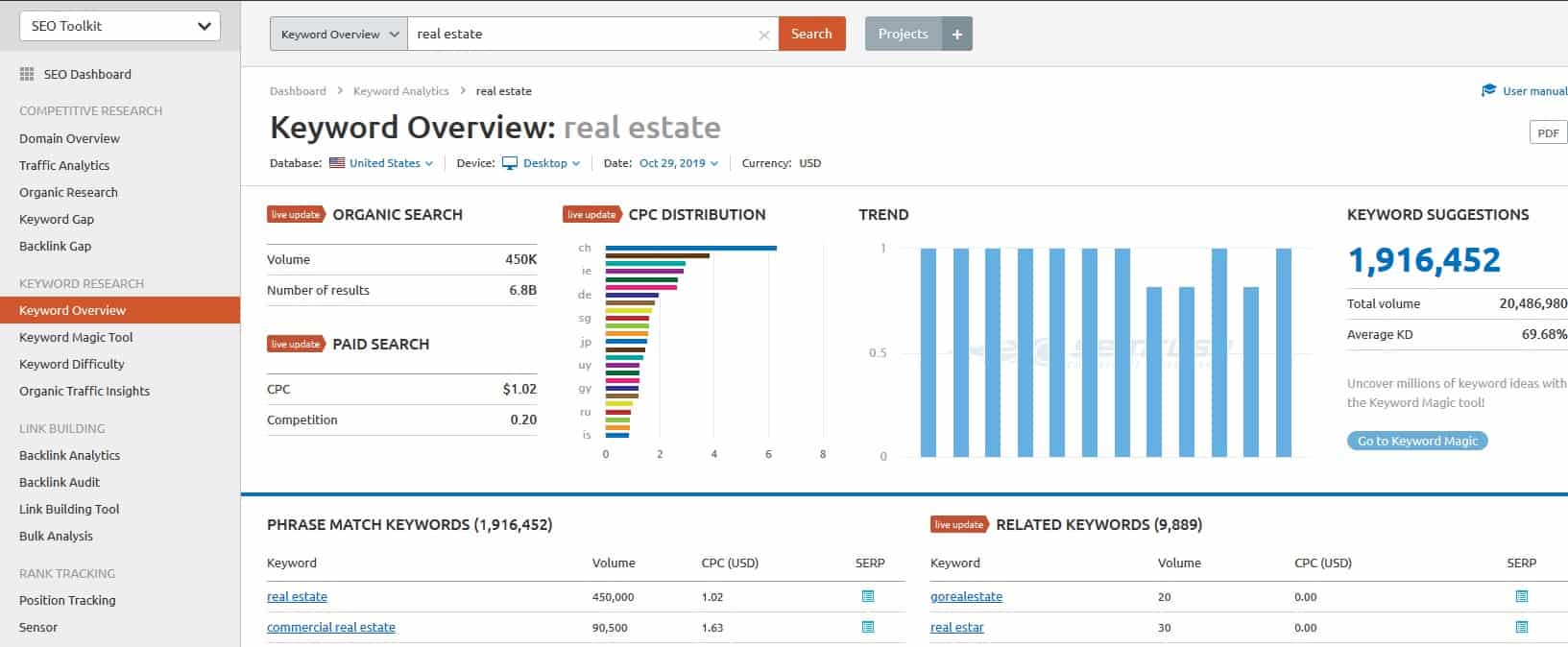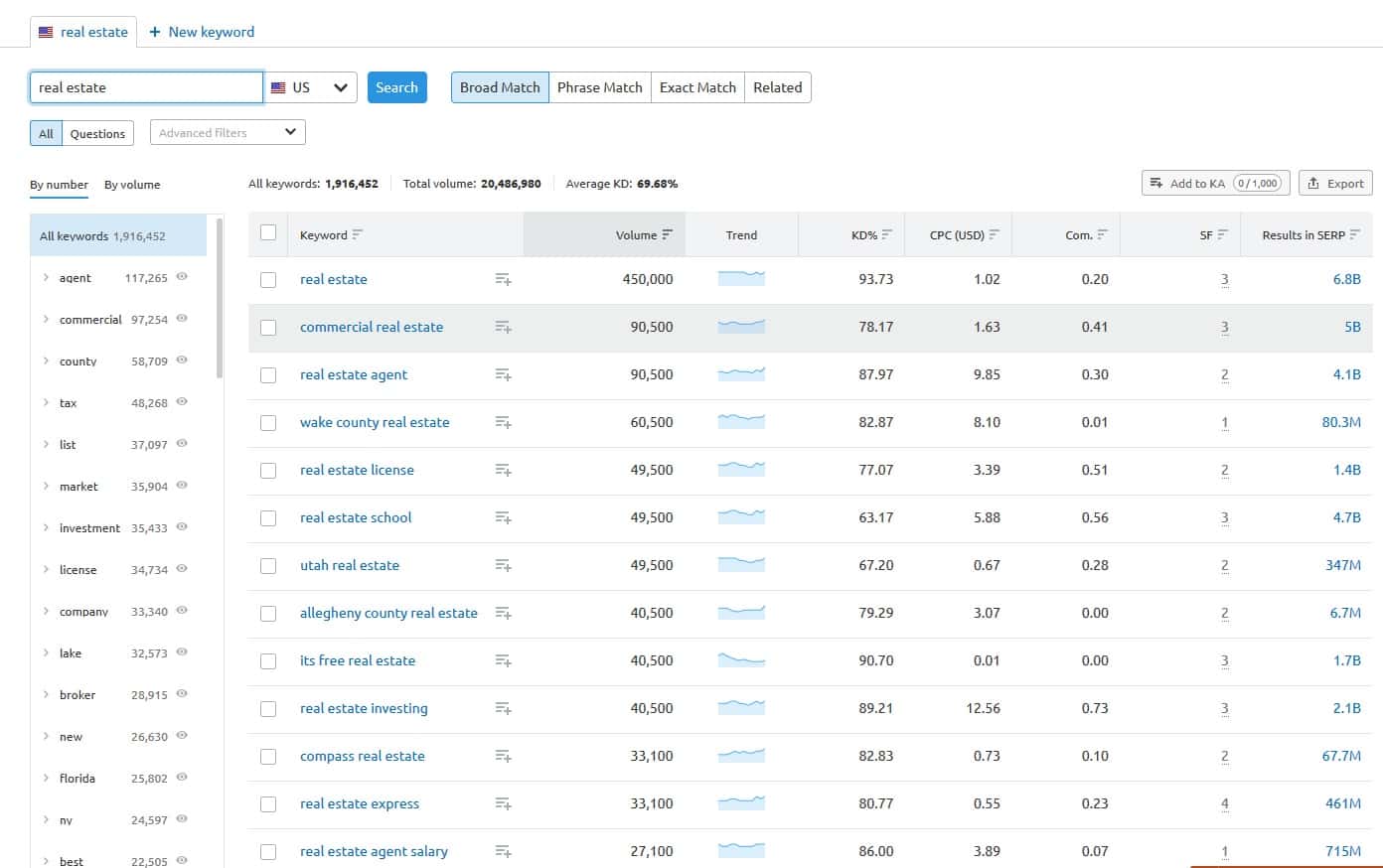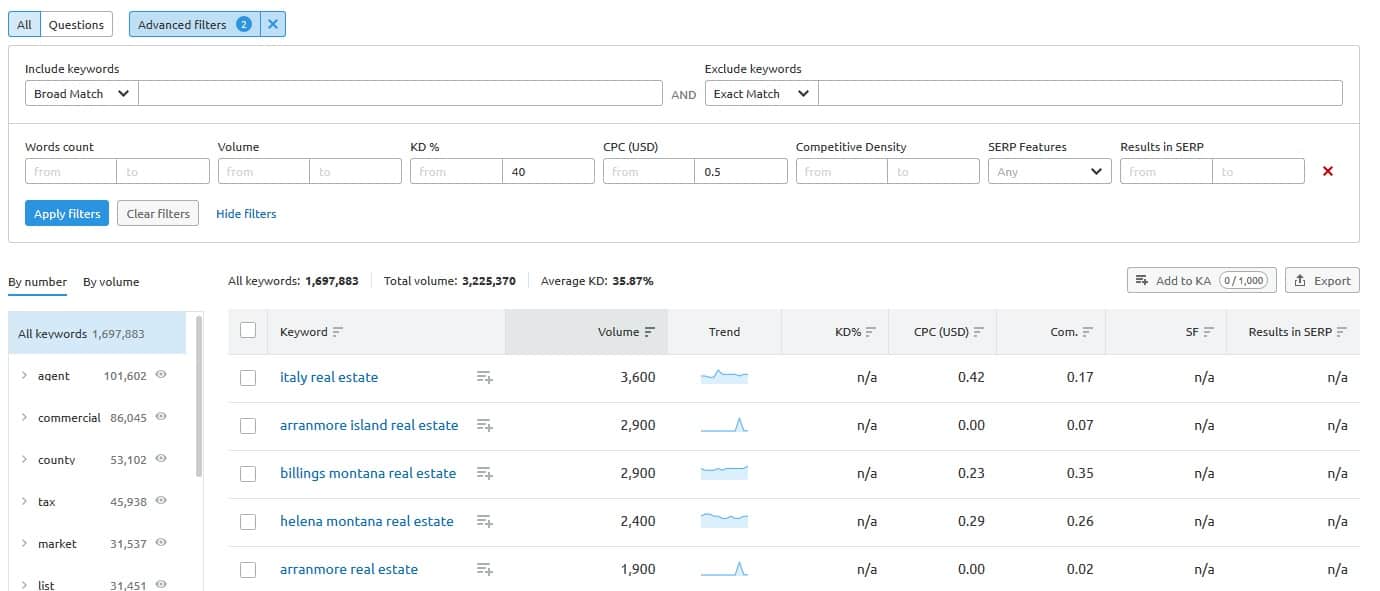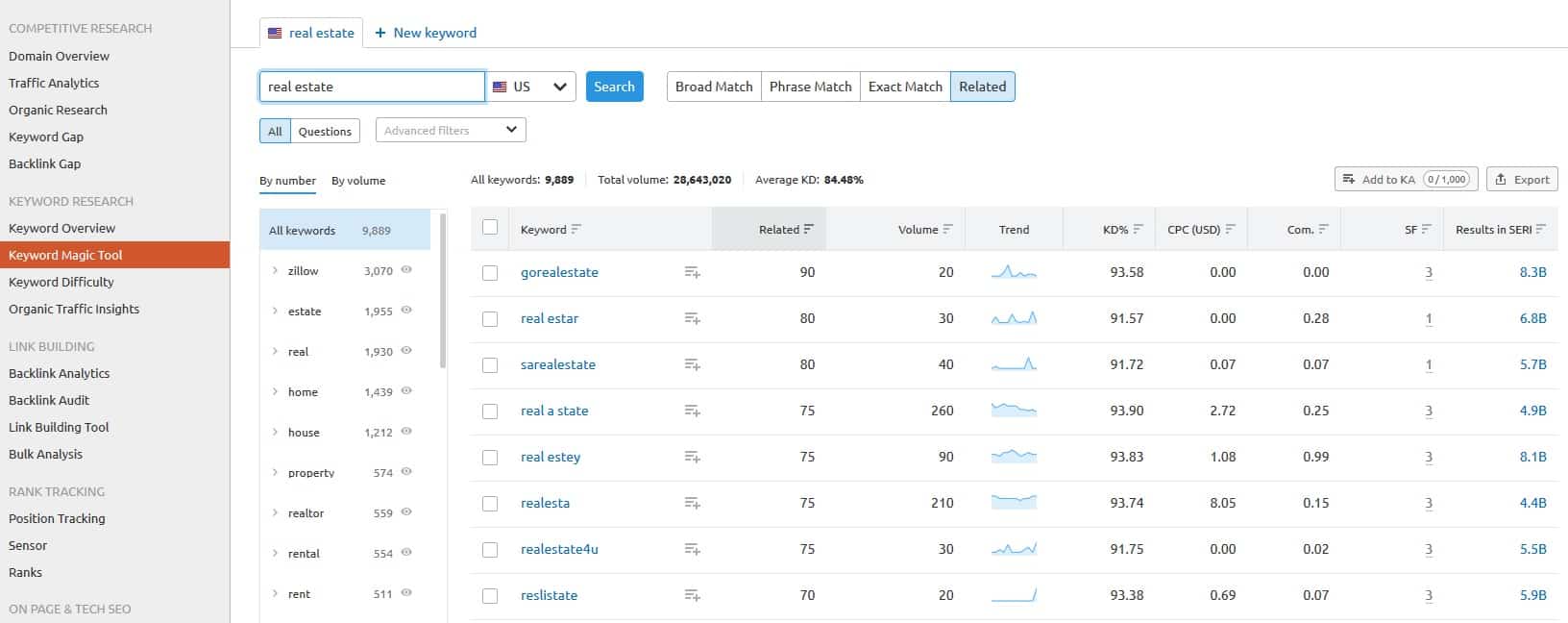Keyword research checklist for PPC, SEO
A business or other website will get many visitors, leads, and orders only if it ranks well in search engine results or the advertiser runs a Pay-per-click (PPC) advertising campaign. Internet users search for information using keywords related to the business’s products and services. Similarly, PPC advertisements are also shown based on the keywords used for searching by the internet user. Hence, a company must prepare a comprehensive website keyword list. A keyword research checklist is provided below. The success of the SEO and PPC campaign depends mainly on the keyword list.
Step 1: Search Your Main Keyword
Searching for the main keyword
The first step in preparing the keyword list is finding the main keyword for the business website. This is usually related to the product or service the business sells. Alternatively, it could be a term that describes the company in the best possible way. Tools like SEM Rush have information on more than 1 billion terms that internet users search. The main keyword is usually a single word or two words to describe the business. The research tool will then provide information on the search volume for the keyword and other related information.
Using Semrush tool , we can try the keyword tool, and we can search for the “real estate” keyword :
, we can try the keyword tool, and we can search for the “real estate” keyword :

Using this tool, you will “expand” lists of keyword ideas.
Step 2: How to Use the SEMRUSH Phrase Match Report to Find Long Tail Keywords
Generating long tail keywords
The term long tail was first coined by Chris Anderson in 2004. It is a unique strategy used in an e-commerce business that allows a company to profit from low-demand products by selling them in small volumes to a relatively large group of people. The basic concept of this theory is that lots of low-demanding products achieve market share and give competition to the relatively popular products and ultimately end up as blockbusters. The only requirement will be a big store where you can stock those products. Hence, this technique might prove handy in online businesses without an environment to nurture an actual shop.
A similar concept goes into search engine promotion, where the term long tail relates to the keyword. Long-tail keywords are those keywords that have a low search index and less traffic. However, it is seen that when those long keywords combine with similar ones, they produce more traffic compared to the high-value ones.
Promoting a long-tail keyword is easy using Semrush’s Long Tail Keyword Generator. It can be done by optimizing the website for three or four keyword phrases. These phrases will attract many visitors who order the desired product or service.
Although long-tail marketing is not practical for promoting services or small products, on a giant scale like that of an e-commerce business or content site, those long phrases will bring more traffic.
You can start using the strategy on your website, too. First, do extensive research for the long tail phrase. The entire research process is precisely the same as regular keyword research. Use different methods to find the keywords, but not hang them on the same source. After that, you will get the following choices:
Buying a database with all the information on related keywords suiting your niche may be an option. They are not expensive and can help you with your research. Keep in mind that you must be careful while purchasing databases. If needed, check a few parts of it. If it feels good to you, proceed to buy. You can also purchase similar databases and integrate them to get a good list of those keywords.
Another good option is to use a Long-tail keyword generator tool. Many paid and free generators are scattered on the Internet. Take some time to inspect them properly. You will find the ultimate solution that suits your needs.
You can use Semrush dot com to generate keywords. For example, if you type’ Internet marketing’ using this tool, you can have more than 1300 combinations that contain the phrase. You can export this information in any format and personally sort the long-tailed keywords.
Synonyms are essential in SEO, and a good Keyword Report is equally important. Searching the phrase’ internet marketing will fetch you over 2200 entries. You can clearly understand what that synonym can add to your target audience.
Lastly, you can use Google Services, such as Google Related Terms, Google Suggest, and Google Insights. These will help you find your desired long-tail keywords.
Whatever option you choose, remember that researching long-tail keywords is not to be done at once. It must be done at regular intervals because the search language changes occasionally.
The main keyword is usually one or two long words and is called a short-tail keyword for keyword research. However, many related terms that internet users use to search for information containing the main keyword are called long-tail keywords. These longer phrases, which may contain up to seven words, are called long-tail keywords. Usually, the number of people searching for long-term keywords in search engines like Google is less; however, these internet users are sometimes more likely to purchase the product or service.
S”e how we can” find the “real estate” long tail k “word user”crush to”l :

Step 3: “How do you apply filters for keyword difficulty (SEO)? How to filter Competitive Density (PPC)
Keyword difficulty and website density
A website’s ranking depends mainly on how much competition it has for a particular keyword. The critical parameter for ranking a website in search engine results is the keyword difficulty, on a scale of 0 to 100. If more authoritative websites are ranked in the search results for the keyword, the keyword difficulty won’t be higher, and it won’t be easy to rank for the keyword. Similarly, if many advertisers bid for the same keyword for PPC, the competitive density will be higher, and the business will have to bid higher to get visitors through PPC.
Usually, more effort and money are required to rank more difficult keywords. Using tools for keyword research, it is possible to find the keyword difficulty and competitive density for each long-tail and short-tail keyword. These parameters, the search volume for each keyword, and the PPC information should be compiled into a spreadsheet like Excel or CSV file for easy reference. The data can then be used to decide a suitable strategy for SEO by ensuring that the website content contains the relevant keywords and displaying PPC ads when the appropriate search terms are shown”.
Here, we “filter “real estate” related key” keywords to find” CPC cheap”r and less “competitive keywords :

Step 4: How do you find related keyword phrases?
Find related keyword phrases.
In addition to the main keyword, there may be other related keywords. Most businesses are selling more than one associated product/service. Hence, it is advisable to do keyword research for all these products and services and find the relevant keywords. Doing a phrase match to find the applicable terms is also advisable. Users will find many typos and spelling mistakes that internet users will type in the search bar when looking for relevant information. The long tail keywords should be generated for the phrase matched, and both Keyword difficulty for SEO and Competitive density for PPC data should be compiled.

Step 5: Generating a master list of keywords
It is advisable to spend some time generating the maximum number of keywords related to the business since this information can help decide the best SEO and PPC strategy for the company. After data has been generated for all relevant short-tail and long-term keywords, this information should be again compiled in an Excel file called the master list, which contains all the details. The master list will have data on the search volumes and PPC bids for each keyword, and based on the competition, the business may decide to focus on keywords with a lower search volume since it will be easier to rank well.
Step 6: Search intent classification
Classifying keywords based on search intent
A business may spend a lot of time generating an extensive keyword list; however, to use it in the best way possible, it is essential to understand the intent of the search engine user when he types the keyword in the search engine. The intent of the user can be broadly classified into four different categories.
– Information: Many internet users look for information about a product, item, or service when they type a keyword. When single words are used for searching, the user only looks for information, like the meaning of the word or related companies.
Navigation: Many internet users are not aware of the exact URL of the website of a particular company or brand selling the product. However, they wish to visit the website to collect more information or contact the company. So, the company finds the company’s URL by typing the brand name or company name into the search engine.
Business research or investigation: Many people use the Internet to search for the various products and services they require or may be interested in purchasing. Sometimes, they may research rivals, customers, vendors, and check-checkers. The search terms will include positive or negative terms like best, worst, or location-specific.
– Transaction: The volume of transaction-related keywords is usually the lowest compared to other keywords for a particular search phrase. Buyers who wish to purchase a specific service or product online or offline will usually type concrete terms like coupons, shipping rates, prices, and discounts to finalize the order as soon as possible.
It is recommended that the business classify each keyword using the abovementioned categories to make it easier to decide which keywords are most relevant.
A business may generate an extensive list of SEO and PPC advertising keywords. Unless they are categorized correctly to finalize the advertising and SEO strategy, the company may not get the desired results.
Go and try the free Semrush tool .
.
- Facebook Ads to Get Followers! - December 27, 2024
- ClickUp vs. Slack - December 20, 2024
- Mastering E-Commerce Analytics: A Blueprint for Success




